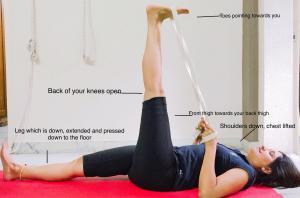The word prop may bring to mind objects used by actors in a play or by dancers in a performance. But here I am talking about yoga props. This is an object used to support your body and help you to get the most out of every pose you do. Props are especially useful to beginners to achieve the final pose or to make a pose ‘safer’.
“Props are guides to self-learning,” said yoga stalwart Guruji BKS Iyengar, who initiated the use of props in yoga and also designed many props himself . These days, most modern yoga studios will have props like sticky mats, blankets, belts, blocks, chairs, bolsters, wall ropes and sand bags.
Why do I need to use a yoga prop?
You may think that if yoga is all about reconnecting with your body why use external supports such as props. Well many asanas, such as inversions and backbends, bring us face to face with our fears. And when faced with our fears, it’s human tendency to look for security and a safe zone. For instance, we bend forward easily but it’s not the same for bending backward. For poses like these we can use support, and that is where props help. The use of wall ropes for a backbend can provide you with some anchorage and also give you freedom to move your body.

Even learning to do sirsasana with the support of the wall helps beginners to overcome the fear of falling. A wall can support the body so well that the energy needed for the particular movement is made available. In this way, props can support and stabilize the outer body without restricting the freedom of movement of the inner body or organic body.
How to use yoga props
- To perform asanas which are difficult to do independently.
- To achieve correct alignment in the asana when your body is not strong enough to do the asana.
- To provide support so that a person can receive the maximum benefits of holding a posture for a longer time.
- It also enhances the restorative or therapeutic qualities of a pose
- It helps to support the practitioner to work in a range of motion that is safe and effective.
- To stay longer and relax in any asana practice to get the maximum benefits.
- It also helps in pranayama by giving support to the body, thus allowing the mind to relax.
A yoga block is the most wonderful tool to bring the floor closer to your body. A belt makes your arms longer, while bolsters and blankets are the most comfortable companions to take your savasana to a whole new level. Using yoga props is not a sign of weakness, rather it is an intelligent way of maneuvering your body.
Some ways to use props to change your asana practice
- Use blocks under your arms in Urdhva Mukha Svanasana [upward facing dog] to get a higher lift of the chest and to lengthen your spine further.

Upward dog with blocks - Loop a belt around the arch of your foot in Supta padangustasana [lying down, hand to toe] instead of craning your neck and shoulders to reach your toes and find more release in the upper body and hamstrings.
- Start your yoga practice lying over a bolster with arms dropping onto the floor for gentle chest opening.
- Blanket and belt can be use for Janu shirsasana [head to knee] too. Sit on a blanket or block to elevate your hips so your tailbone and sacrum area becomes free. Hook the belt to the leg which is straight.

Using the belt helps you avoid doing forward bends with a hunchback and stay out of what I call “Quasimodo Land”. It is easy for the chest to cave in during forward bends and twists. Belts are very helpful to lift the chest and lengthen the spine.
- During Savasana, place a bolster under your knees for a more gentle position for the low back.
- From opening of the body to stabilizing a pose, there are many ways the wall can assist you in your practice. One way is Uttana asana [standing forward bend] with the wall. Stand with your back facing the wall, keep your chest lifted and feet will be placed hip width apart. Lean forward, bend your knees and bring your hips against the wall. Press down through the outer edges of your feet, as you begin to lift your sitting bones higher up the wall to straighten your legs. Stay in this pose for few seconds.
- Another way of using the wall is Half Handstand in L-shape. This is a killer core workout. Come into Adhomukha svanasana [downward dog] position with your feet towards the wall. Take one foot up the wall, at about the height of your hips. Then take the second leg up to join the first. Straighten both knees, pressing the sole of your feet into the wall. Lower your legs back one at a time, pulling back through your core. Stay in this pose for few seconds

Props can be used in endless ways, according to the situation and need of the practitioner. Once you progress in the pose, you can stop using the prop. Props help to achieve steadiness and ease in every pose, which is the very thing that the ancient sage Patanjali wrote in Yoga Sutra 2.46: sthira sukham asanam.
 Spot an error in this article? A typo maybe? Or an incorrect source? Let us know!
Spot an error in this article? A typo maybe? Or an incorrect source? Let us know!

Helpful information and pic are very well illusrtated also helpful person like me
Nice Very good